Enhancing Cognitive Skills Through Art: Activities for Young Children
VerifiedAdded on 2023/06/07
|24
|3922
|157
Practical Assignment
AI Summary
This assignment presents a practical guide to incorporating art into early childhood education, focusing on children aged 5-6. It outlines three distinct activities: sensory play using dough, fine drawing exercises, and construction activities with blocks. The activities are designed to enhance various developmental aspects, including fine and gross motor skills, cognitive abilities, and creative expression. The assignment details learning intentions, required materials, and strategies for implementation, including the teacher's role and assessment methods. The activities are grounded in developmental psychology, emphasizing the importance of play-based learning and social interaction in fostering children's understanding of the world. Modifications are suggested for different ability levels. The document includes references to relevant research and resources, such as videos and online materials, to support the activities and provide a comprehensive understanding of the topic.
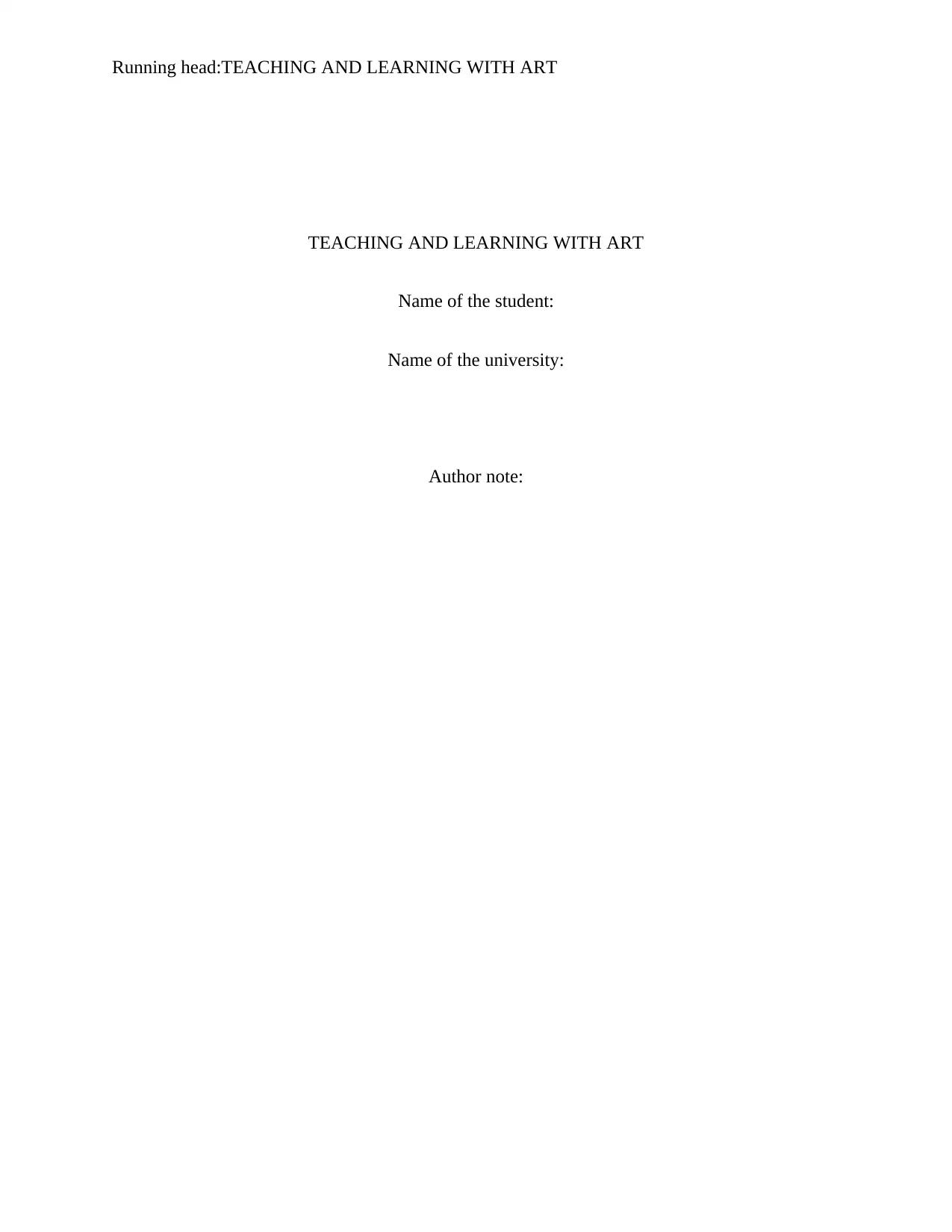
Running head:TEACHING AND LEARNING WITH ART
TEACHING AND LEARNING WITH ART
Name of the student:
Name of the university:
Author note:
TEACHING AND LEARNING WITH ART
Name of the student:
Name of the university:
Author note:
Paraphrase This Document
Need a fresh take? Get an instant paraphrase of this document with our AI Paraphraser
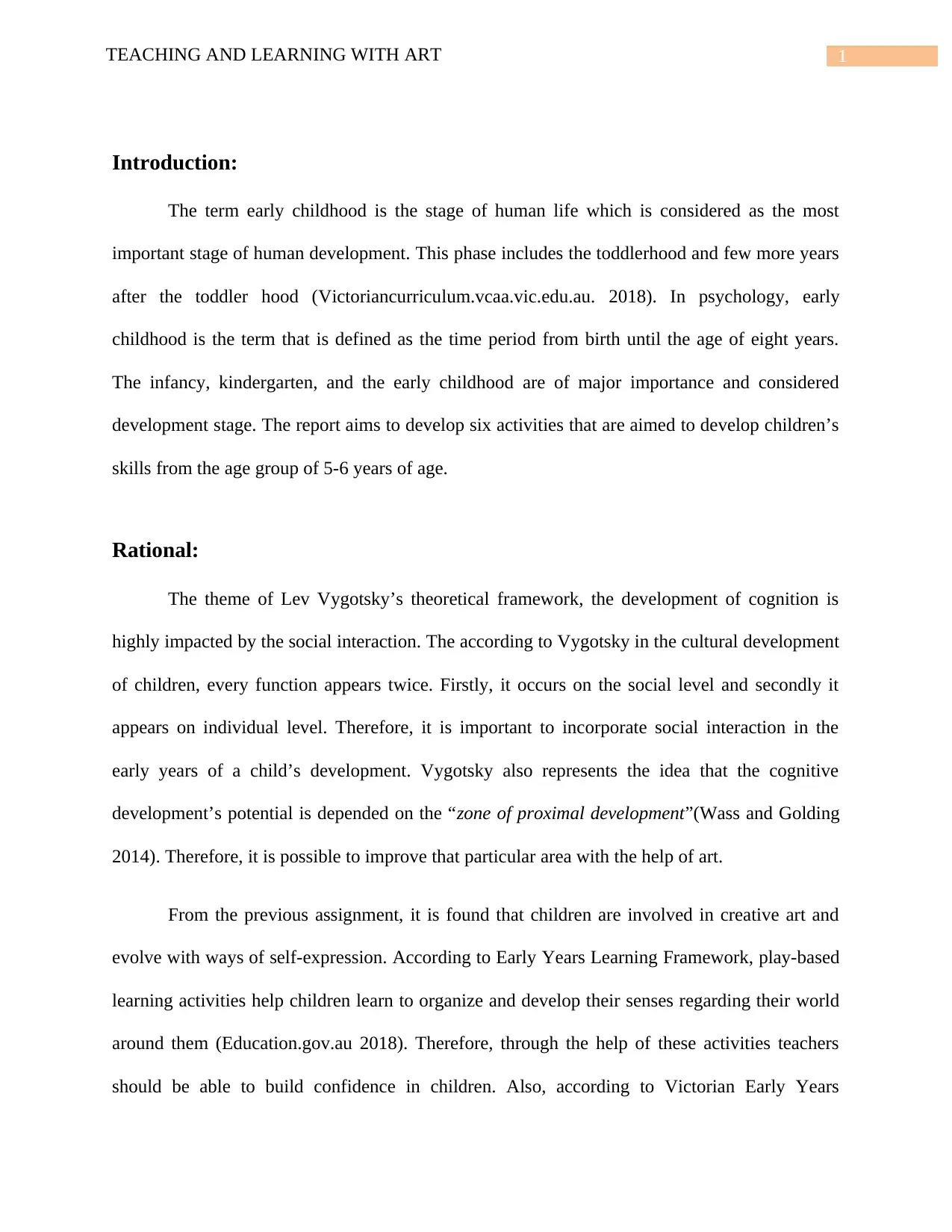
1TEACHING AND LEARNING WITH ART
Introduction:
The term early childhood is the stage of human life which is considered as the most
important stage of human development. This phase includes the toddlerhood and few more years
after the toddler hood (Victoriancurriculum.vcaa.vic.edu.au. 2018). In psychology, early
childhood is the term that is defined as the time period from birth until the age of eight years.
The infancy, kindergarten, and the early childhood are of major importance and considered
development stage. The report aims to develop six activities that are aimed to develop children’s
skills from the age group of 5-6 years of age.
Rational:
The theme of Lev Vygotsky’s theoretical framework, the development of cognition is
highly impacted by the social interaction. The according to Vygotsky in the cultural development
of children, every function appears twice. Firstly, it occurs on the social level and secondly it
appears on individual level. Therefore, it is important to incorporate social interaction in the
early years of a child’s development. Vygotsky also represents the idea that the cognitive
development’s potential is depended on the “zone of proximal development”(Wass and Golding
2014). Therefore, it is possible to improve that particular area with the help of art.
From the previous assignment, it is found that children are involved in creative art and
evolve with ways of self-expression. According to Early Years Learning Framework, play-based
learning activities help children learn to organize and develop their senses regarding their world
around them (Education.gov.au 2018). Therefore, through the help of these activities teachers
should be able to build confidence in children. Also, according to Victorian Early Years
Introduction:
The term early childhood is the stage of human life which is considered as the most
important stage of human development. This phase includes the toddlerhood and few more years
after the toddler hood (Victoriancurriculum.vcaa.vic.edu.au. 2018). In psychology, early
childhood is the term that is defined as the time period from birth until the age of eight years.
The infancy, kindergarten, and the early childhood are of major importance and considered
development stage. The report aims to develop six activities that are aimed to develop children’s
skills from the age group of 5-6 years of age.
Rational:
The theme of Lev Vygotsky’s theoretical framework, the development of cognition is
highly impacted by the social interaction. The according to Vygotsky in the cultural development
of children, every function appears twice. Firstly, it occurs on the social level and secondly it
appears on individual level. Therefore, it is important to incorporate social interaction in the
early years of a child’s development. Vygotsky also represents the idea that the cognitive
development’s potential is depended on the “zone of proximal development”(Wass and Golding
2014). Therefore, it is possible to improve that particular area with the help of art.
From the previous assignment, it is found that children are involved in creative art and
evolve with ways of self-expression. According to Early Years Learning Framework, play-based
learning activities help children learn to organize and develop their senses regarding their world
around them (Education.gov.au 2018). Therefore, through the help of these activities teachers
should be able to build confidence in children. Also, according to Victorian Early Years
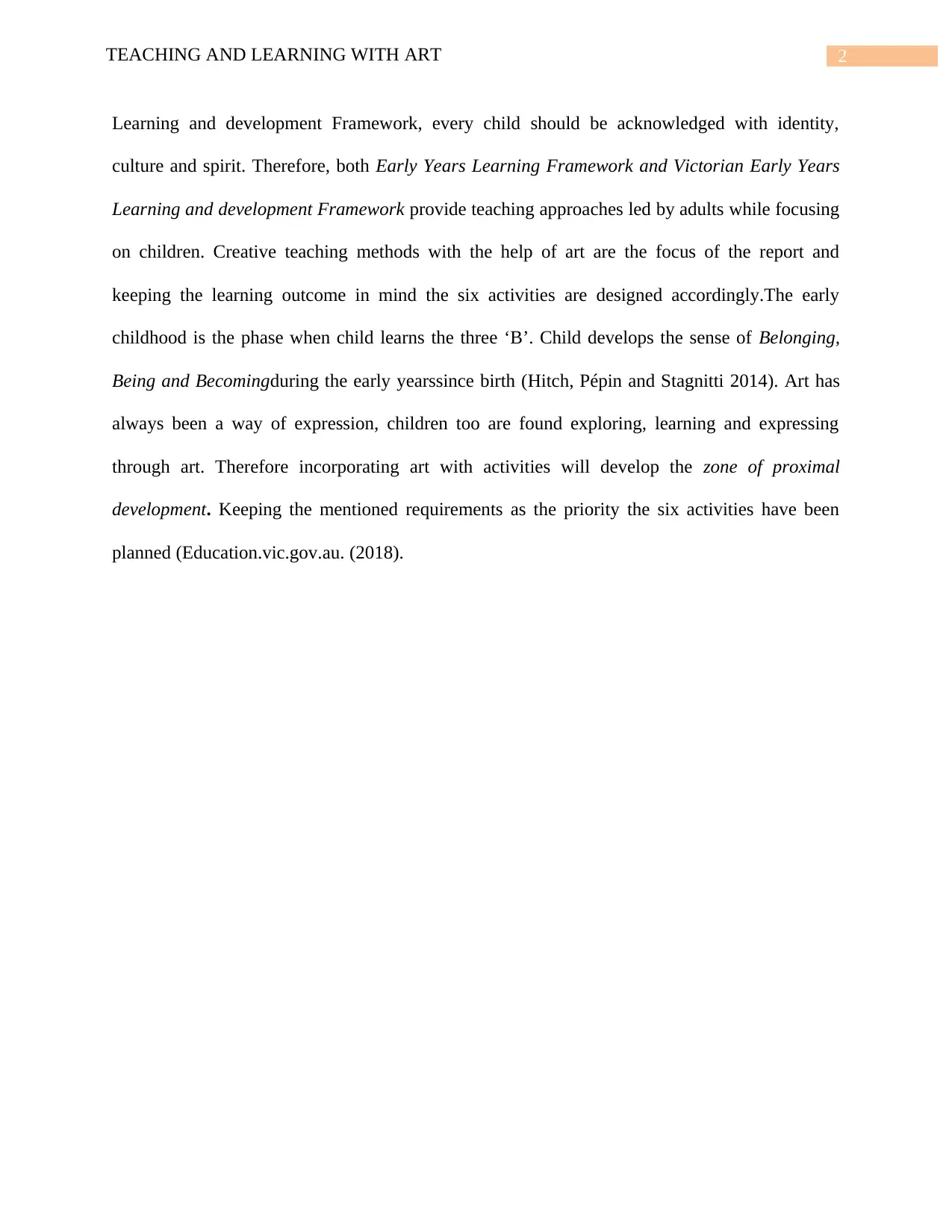
2TEACHING AND LEARNING WITH ART
Learning and development Framework, every child should be acknowledged with identity,
culture and spirit. Therefore, both Early Years Learning Framework and Victorian Early Years
Learning and development Framework provide teaching approaches led by adults while focusing
on children. Creative teaching methods with the help of art are the focus of the report and
keeping the learning outcome in mind the six activities are designed accordingly.The early
childhood is the phase when child learns the three ‘B’. Child develops the sense of Belonging,
Being and Becomingduring the early yearssince birth (Hitch, Pépin and Stagnitti 2014). Art has
always been a way of expression, children too are found exploring, learning and expressing
through art. Therefore incorporating art with activities will develop the zone of proximal
development. Keeping the mentioned requirements as the priority the six activities have been
planned (Education.vic.gov.au. (2018).
Learning and development Framework, every child should be acknowledged with identity,
culture and spirit. Therefore, both Early Years Learning Framework and Victorian Early Years
Learning and development Framework provide teaching approaches led by adults while focusing
on children. Creative teaching methods with the help of art are the focus of the report and
keeping the learning outcome in mind the six activities are designed accordingly.The early
childhood is the phase when child learns the three ‘B’. Child develops the sense of Belonging,
Being and Becomingduring the early yearssince birth (Hitch, Pépin and Stagnitti 2014). Art has
always been a way of expression, children too are found exploring, learning and expressing
through art. Therefore incorporating art with activities will develop the zone of proximal
development. Keeping the mentioned requirements as the priority the six activities have been
planned (Education.vic.gov.au. (2018).
⊘ This is a preview!⊘
Do you want full access?
Subscribe today to unlock all pages.

Trusted by 1+ million students worldwide
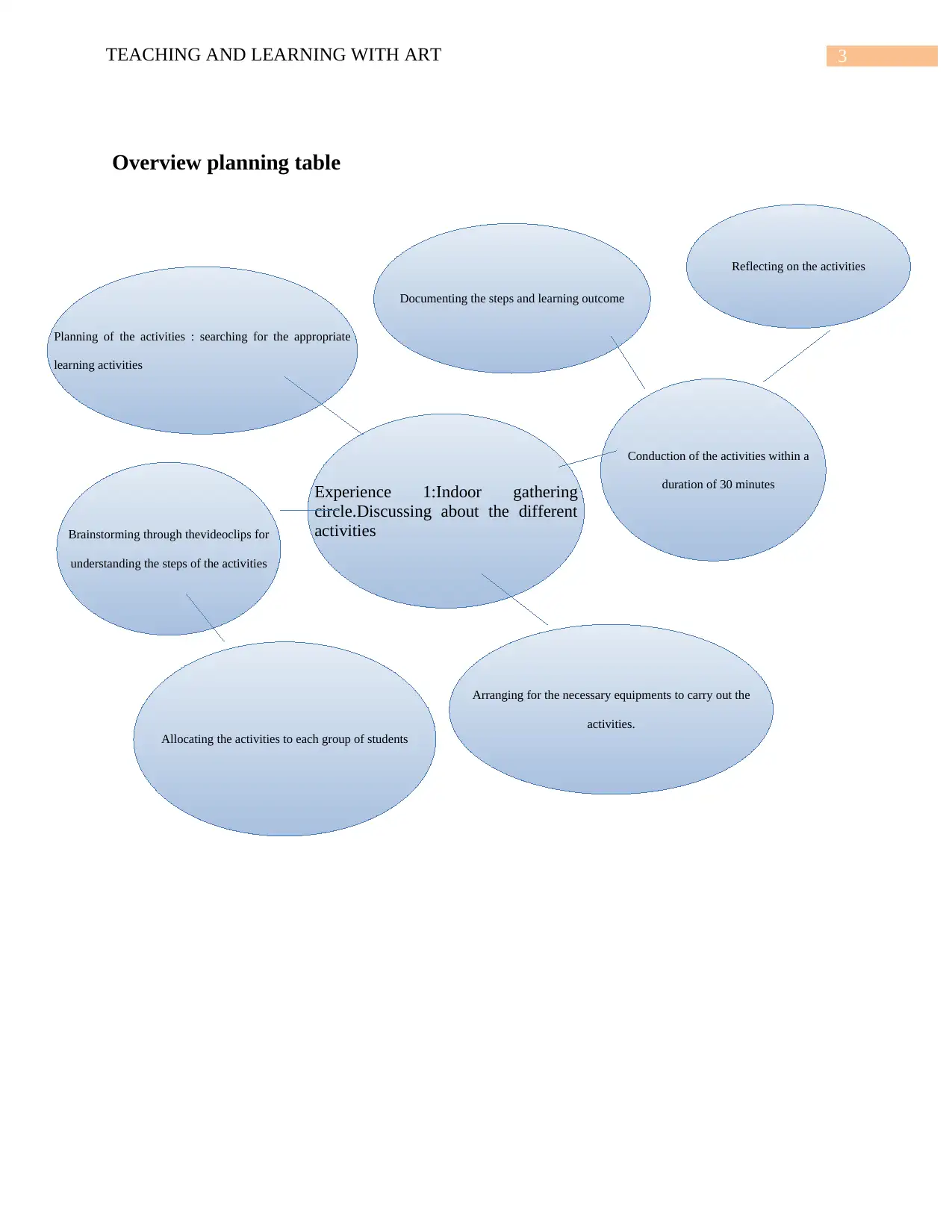
3TEACHING AND LEARNING WITH ART
Overview planning table
Planning of the activities : searching for the appropriate
learning activities
Conduction of the activities within a
duration of 30 minutes
Brainstorming through thevideoclips for
understanding the steps of the activities
Experience 1:Indoor gathering
circle.Discussing about the different
activities
Reflecting on the activities
Arranging for the necessary equipments to carry out the
activities.
Allocating the activities to each group of students
Documenting the steps and learning outcome
Overview planning table
Planning of the activities : searching for the appropriate
learning activities
Conduction of the activities within a
duration of 30 minutes
Brainstorming through thevideoclips for
understanding the steps of the activities
Experience 1:Indoor gathering
circle.Discussing about the different
activities
Reflecting on the activities
Arranging for the necessary equipments to carry out the
activities.
Allocating the activities to each group of students
Documenting the steps and learning outcome
Paraphrase This Document
Need a fresh take? Get an instant paraphrase of this document with our AI Paraphraser
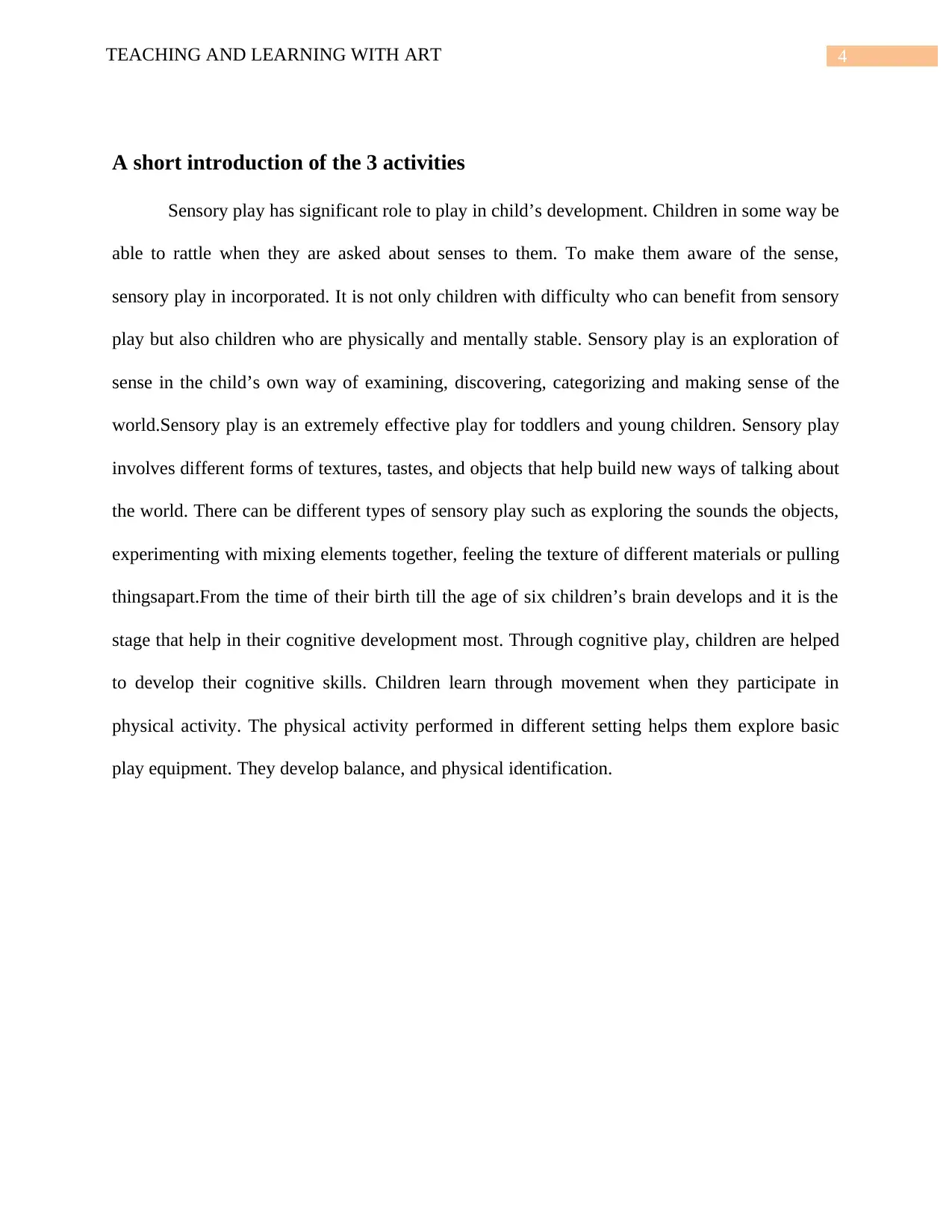
4TEACHING AND LEARNING WITH ART
A short introduction of the 3 activities
Sensory play has significant role to play in child’s development. Children in some way be
able to rattle when they are asked about senses to them. To make them aware of the sense,
sensory play in incorporated. It is not only children with difficulty who can benefit from sensory
play but also children who are physically and mentally stable. Sensory play is an exploration of
sense in the child’s own way of examining, discovering, categorizing and making sense of the
world.Sensory play is an extremely effective play for toddlers and young children. Sensory play
involves different forms of textures, tastes, and objects that help build new ways of talking about
the world. There can be different types of sensory play such as exploring the sounds the objects,
experimenting with mixing elements together, feeling the texture of different materials or pulling
thingsapart.From the time of their birth till the age of six children’s brain develops and it is the
stage that help in their cognitive development most. Through cognitive play, children are helped
to develop their cognitive skills. Children learn through movement when they participate in
physical activity. The physical activity performed in different setting helps them explore basic
play equipment. They develop balance, and physical identification.
A short introduction of the 3 activities
Sensory play has significant role to play in child’s development. Children in some way be
able to rattle when they are asked about senses to them. To make them aware of the sense,
sensory play in incorporated. It is not only children with difficulty who can benefit from sensory
play but also children who are physically and mentally stable. Sensory play is an exploration of
sense in the child’s own way of examining, discovering, categorizing and making sense of the
world.Sensory play is an extremely effective play for toddlers and young children. Sensory play
involves different forms of textures, tastes, and objects that help build new ways of talking about
the world. There can be different types of sensory play such as exploring the sounds the objects,
experimenting with mixing elements together, feeling the texture of different materials or pulling
thingsapart.From the time of their birth till the age of six children’s brain develops and it is the
stage that help in their cognitive development most. Through cognitive play, children are helped
to develop their cognitive skills. Children learn through movement when they participate in
physical activity. The physical activity performed in different setting helps them explore basic
play equipment. They develop balance, and physical identification.
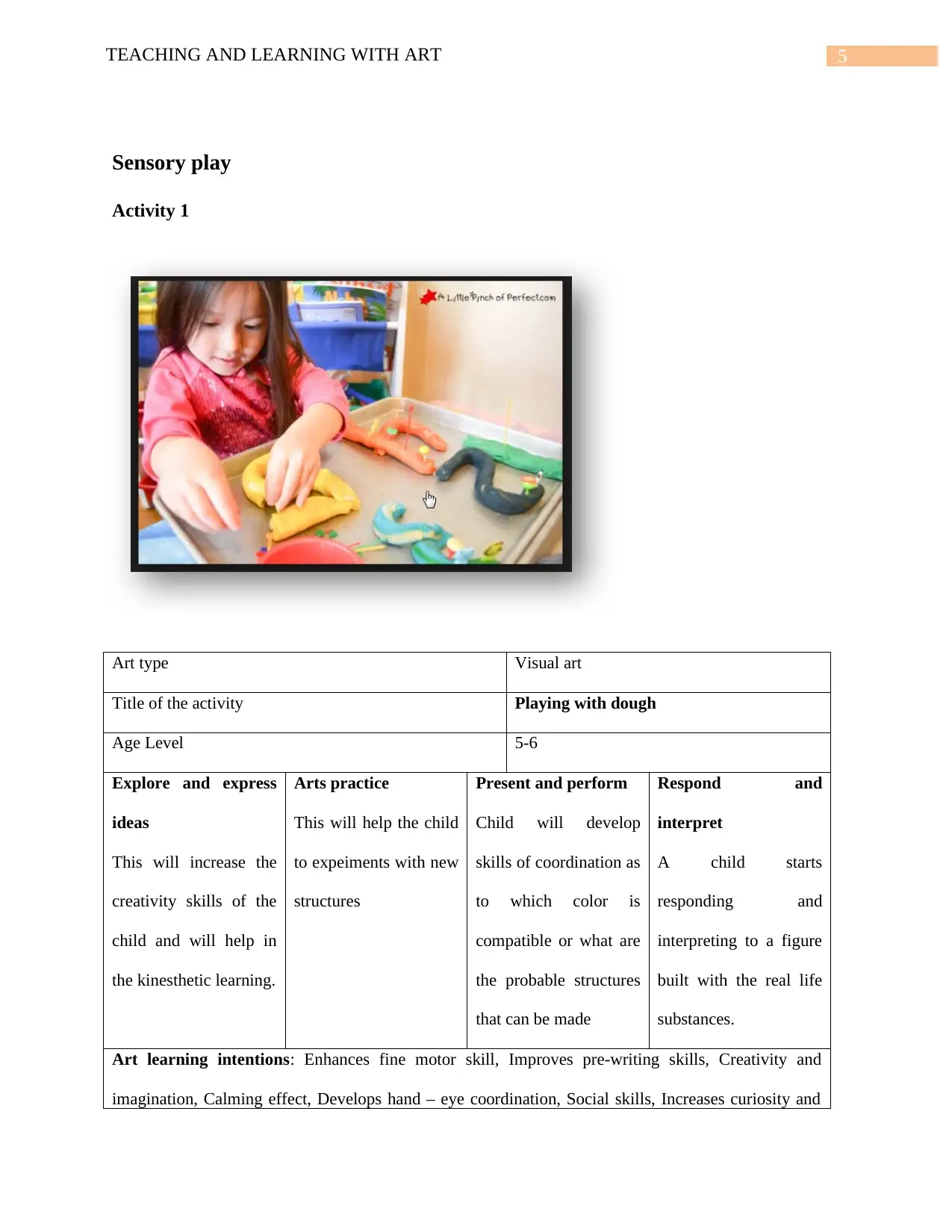
5TEACHING AND LEARNING WITH ART
Sensory play
Activity 1
Art type Visual art
Title of the activity Playing with dough
Age Level 5-6
Explore and express
ideas
This will increase the
creativity skills of the
child and will help in
the kinesthetic learning.
Arts practice
This will help the child
to expeiments with new
structures
Present and perform
Child will develop
skills of coordination as
to which color is
compatible or what are
the probable structures
that can be made
Respond and
interpret
A child starts
responding and
interpreting to a figure
built with the real life
substances.
Art learning intentions: Enhances fine motor skill, Improves pre-writing skills, Creativity and
imagination, Calming effect, Develops hand – eye coordination, Social skills, Increases curiosity and
Sensory play
Activity 1
Art type Visual art
Title of the activity Playing with dough
Age Level 5-6
Explore and express
ideas
This will increase the
creativity skills of the
child and will help in
the kinesthetic learning.
Arts practice
This will help the child
to expeiments with new
structures
Present and perform
Child will develop
skills of coordination as
to which color is
compatible or what are
the probable structures
that can be made
Respond and
interpret
A child starts
responding and
interpreting to a figure
built with the real life
substances.
Art learning intentions: Enhances fine motor skill, Improves pre-writing skills, Creativity and
imagination, Calming effect, Develops hand – eye coordination, Social skills, Increases curiosity and
⊘ This is a preview!⊘
Do you want full access?
Subscribe today to unlock all pages.

Trusted by 1+ million students worldwide
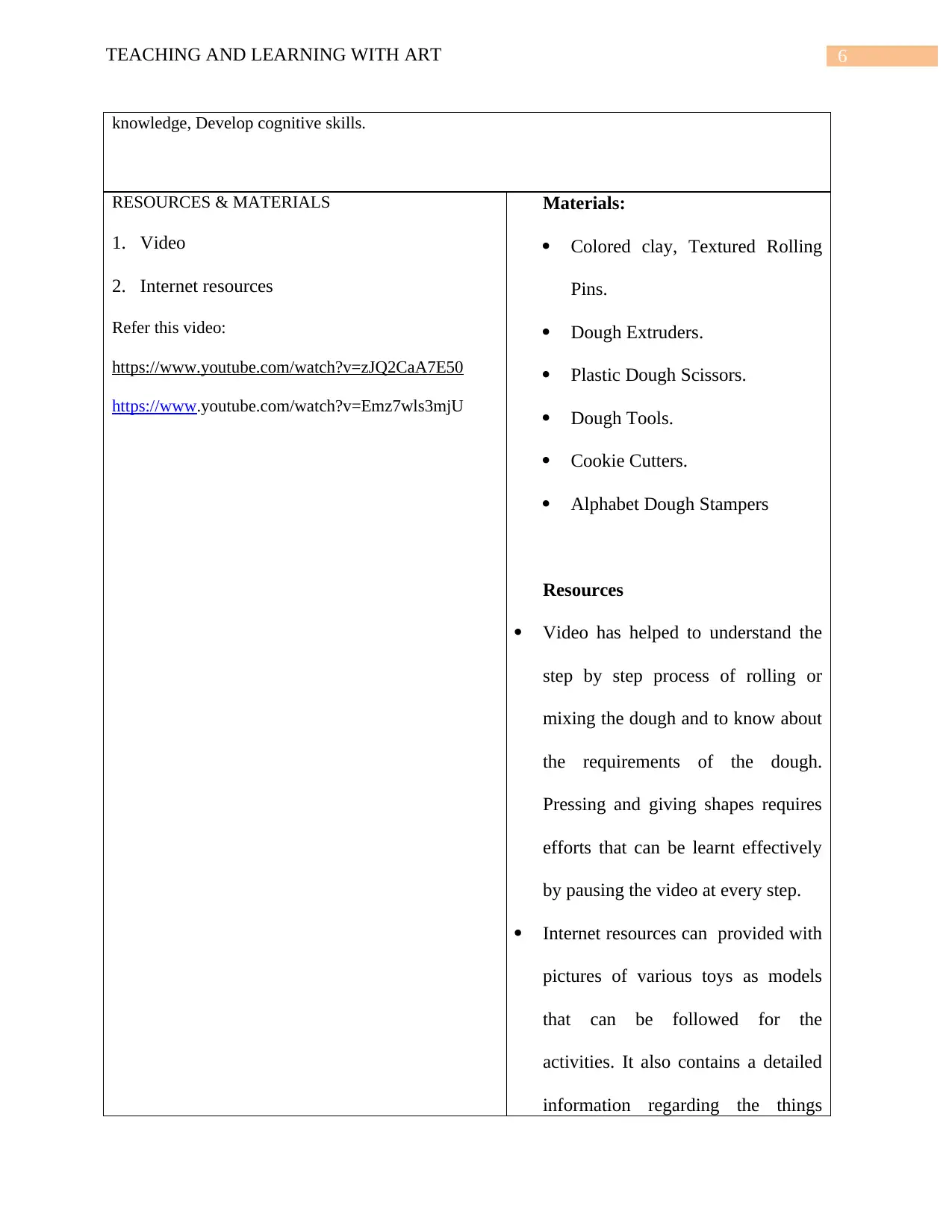
6TEACHING AND LEARNING WITH ART
knowledge, Develop cognitive skills.
RESOURCES & MATERIALS
1. Video
2. Internet resources
Refer this video:
https://www.youtube.com/watch?v=zJQ2CaA7E50
https://www.youtube.com/watch?v=Emz7wls3mjU
Materials:
Colored clay, Textured Rolling
Pins.
Dough Extruders.
Plastic Dough Scissors.
Dough Tools.
Cookie Cutters.
Alphabet Dough Stampers
Resources
Video has helped to understand the
step by step process of rolling or
mixing the dough and to know about
the requirements of the dough.
Pressing and giving shapes requires
efforts that can be learnt effectively
by pausing the video at every step.
Internet resources can provided with
pictures of various toys as models
that can be followed for the
activities. It also contains a detailed
information regarding the things
knowledge, Develop cognitive skills.
RESOURCES & MATERIALS
1. Video
2. Internet resources
Refer this video:
https://www.youtube.com/watch?v=zJQ2CaA7E50
https://www.youtube.com/watch?v=Emz7wls3mjU
Materials:
Colored clay, Textured Rolling
Pins.
Dough Extruders.
Plastic Dough Scissors.
Dough Tools.
Cookie Cutters.
Alphabet Dough Stampers
Resources
Video has helped to understand the
step by step process of rolling or
mixing the dough and to know about
the requirements of the dough.
Pressing and giving shapes requires
efforts that can be learnt effectively
by pausing the video at every step.
Internet resources can provided with
pictures of various toys as models
that can be followed for the
activities. It also contains a detailed
information regarding the things
Paraphrase This Document
Need a fresh take? Get an instant paraphrase of this document with our AI Paraphraser
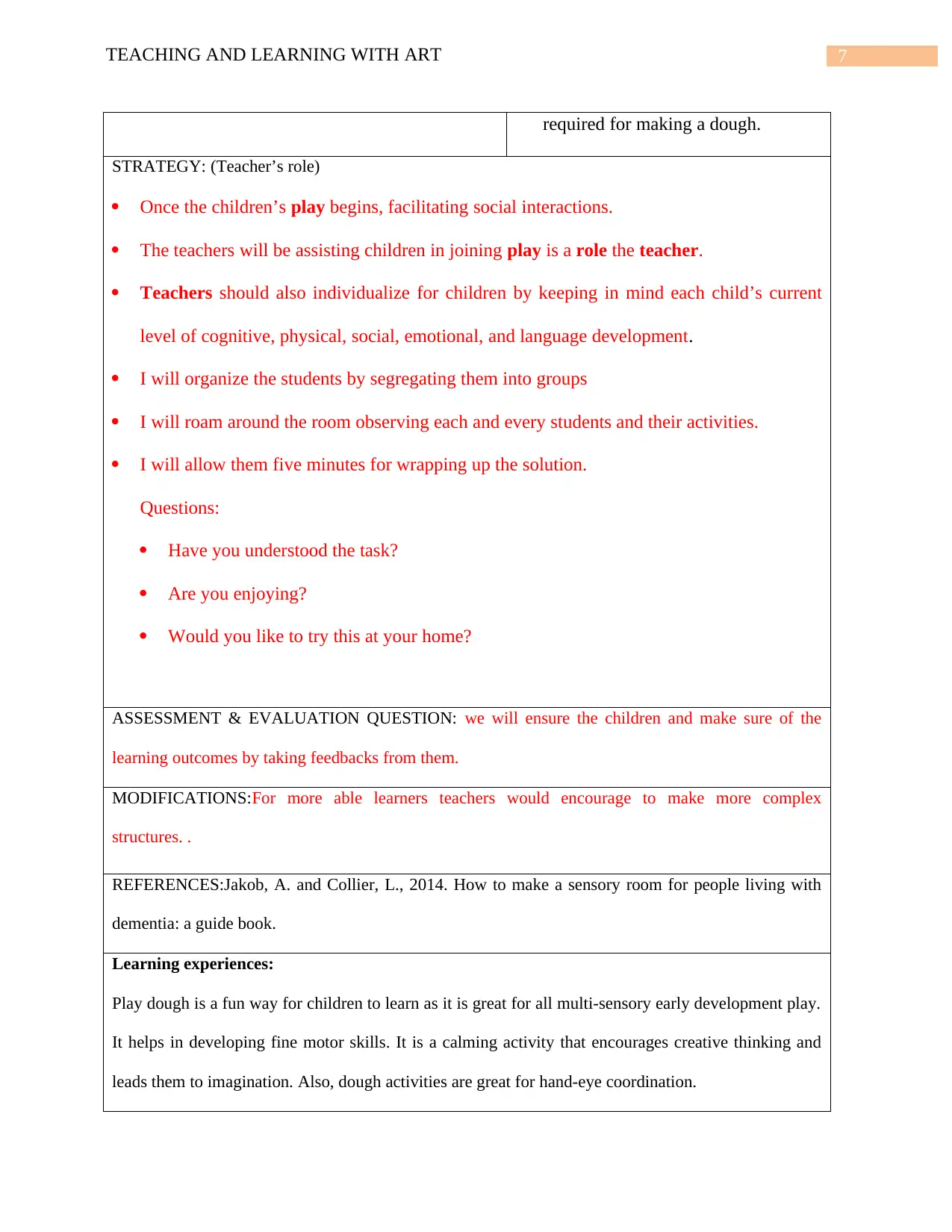
7TEACHING AND LEARNING WITH ART
required for making a dough.
STRATEGY: (Teacher’s role)
Once the children’s play begins, facilitating social interactions.
The teachers will be assisting children in joining play is a role the teacher.
Teachers should also individualize for children by keeping in mind each child’s current
level of cognitive, physical, social, emotional, and language development.
I will organize the students by segregating them into groups
I will roam around the room observing each and every students and their activities.
I will allow them five minutes for wrapping up the solution.
Questions:
Have you understood the task?
Are you enjoying?
Would you like to try this at your home?
ASSESSMENT & EVALUATION QUESTION: we will ensure the children and make sure of the
learning outcomes by taking feedbacks from them.
MODIFICATIONS:For more able learners teachers would encourage to make more complex
structures. .
REFERENCES:Jakob, A. and Collier, L., 2014. How to make a sensory room for people living with
dementia: a guide book.
Learning experiences:
Play dough is a fun way for children to learn as it is great for all multi-sensory early development play.
It helps in developing fine motor skills. It is a calming activity that encourages creative thinking and
leads them to imagination. Also, dough activities are great for hand-eye coordination.
required for making a dough.
STRATEGY: (Teacher’s role)
Once the children’s play begins, facilitating social interactions.
The teachers will be assisting children in joining play is a role the teacher.
Teachers should also individualize for children by keeping in mind each child’s current
level of cognitive, physical, social, emotional, and language development.
I will organize the students by segregating them into groups
I will roam around the room observing each and every students and their activities.
I will allow them five minutes for wrapping up the solution.
Questions:
Have you understood the task?
Are you enjoying?
Would you like to try this at your home?
ASSESSMENT & EVALUATION QUESTION: we will ensure the children and make sure of the
learning outcomes by taking feedbacks from them.
MODIFICATIONS:For more able learners teachers would encourage to make more complex
structures. .
REFERENCES:Jakob, A. and Collier, L., 2014. How to make a sensory room for people living with
dementia: a guide book.
Learning experiences:
Play dough is a fun way for children to learn as it is great for all multi-sensory early development play.
It helps in developing fine motor skills. It is a calming activity that encourages creative thinking and
leads them to imagination. Also, dough activities are great for hand-eye coordination.
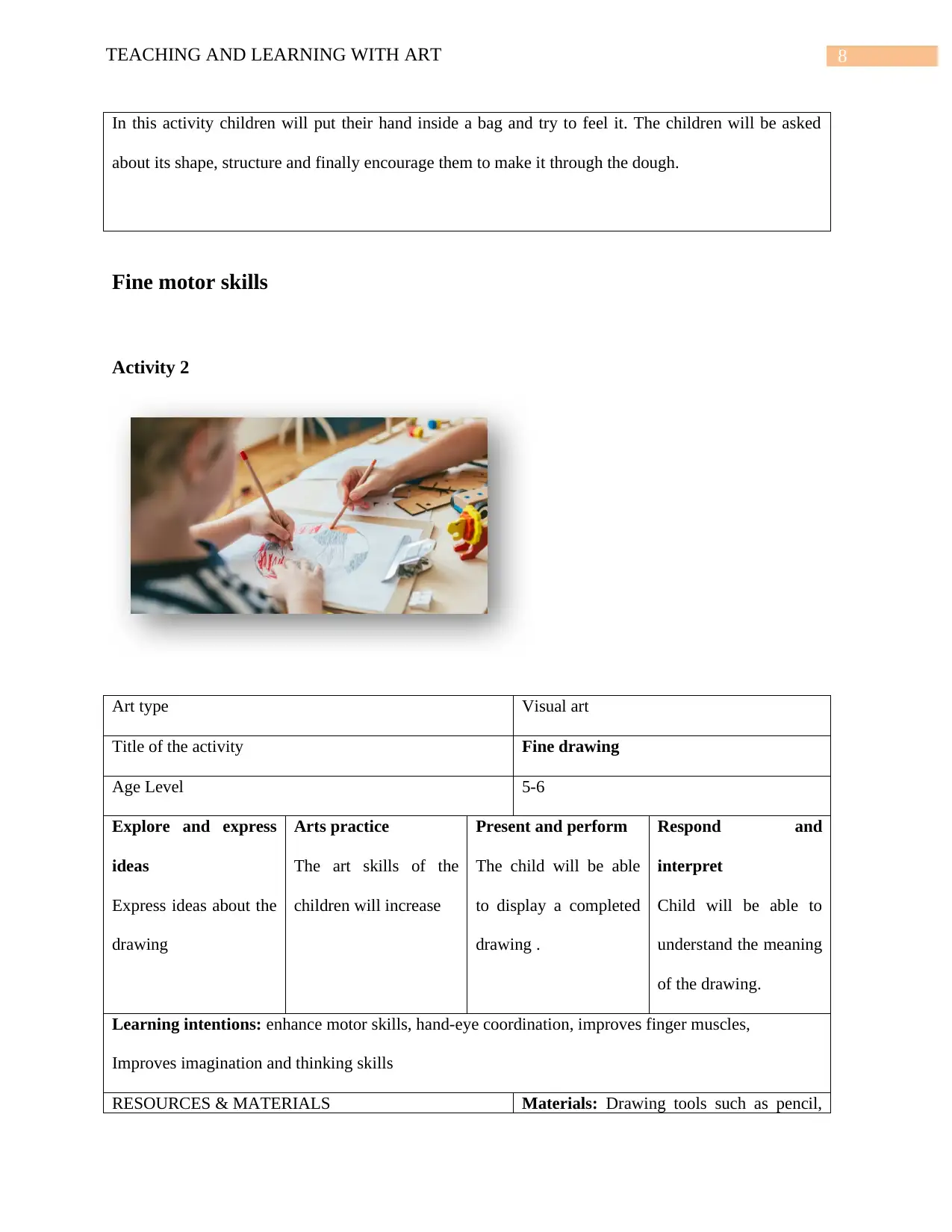
8TEACHING AND LEARNING WITH ART
In this activity children will put their hand inside a bag and try to feel it. The children will be asked
about its shape, structure and finally encourage them to make it through the dough.
Fine motor skills
Activity 2
Art type Visual art
Title of the activity Fine drawing
Age Level 5-6
Explore and express
ideas
Express ideas about the
drawing
Arts practice
The art skills of the
children will increase
Present and perform
The child will be able
to display a completed
drawing .
Respond and
interpret
Child will be able to
understand the meaning
of the drawing.
Learning intentions: enhance motor skills, hand-eye coordination, improves finger muscles,
Improves imagination and thinking skills
RESOURCES & MATERIALS Materials: Drawing tools such as pencil,
In this activity children will put their hand inside a bag and try to feel it. The children will be asked
about its shape, structure and finally encourage them to make it through the dough.
Fine motor skills
Activity 2
Art type Visual art
Title of the activity Fine drawing
Age Level 5-6
Explore and express
ideas
Express ideas about the
drawing
Arts practice
The art skills of the
children will increase
Present and perform
The child will be able
to display a completed
drawing .
Respond and
interpret
Child will be able to
understand the meaning
of the drawing.
Learning intentions: enhance motor skills, hand-eye coordination, improves finger muscles,
Improves imagination and thinking skills
RESOURCES & MATERIALS Materials: Drawing tools such as pencil,
⊘ This is a preview!⊘
Do you want full access?
Subscribe today to unlock all pages.

Trusted by 1+ million students worldwide
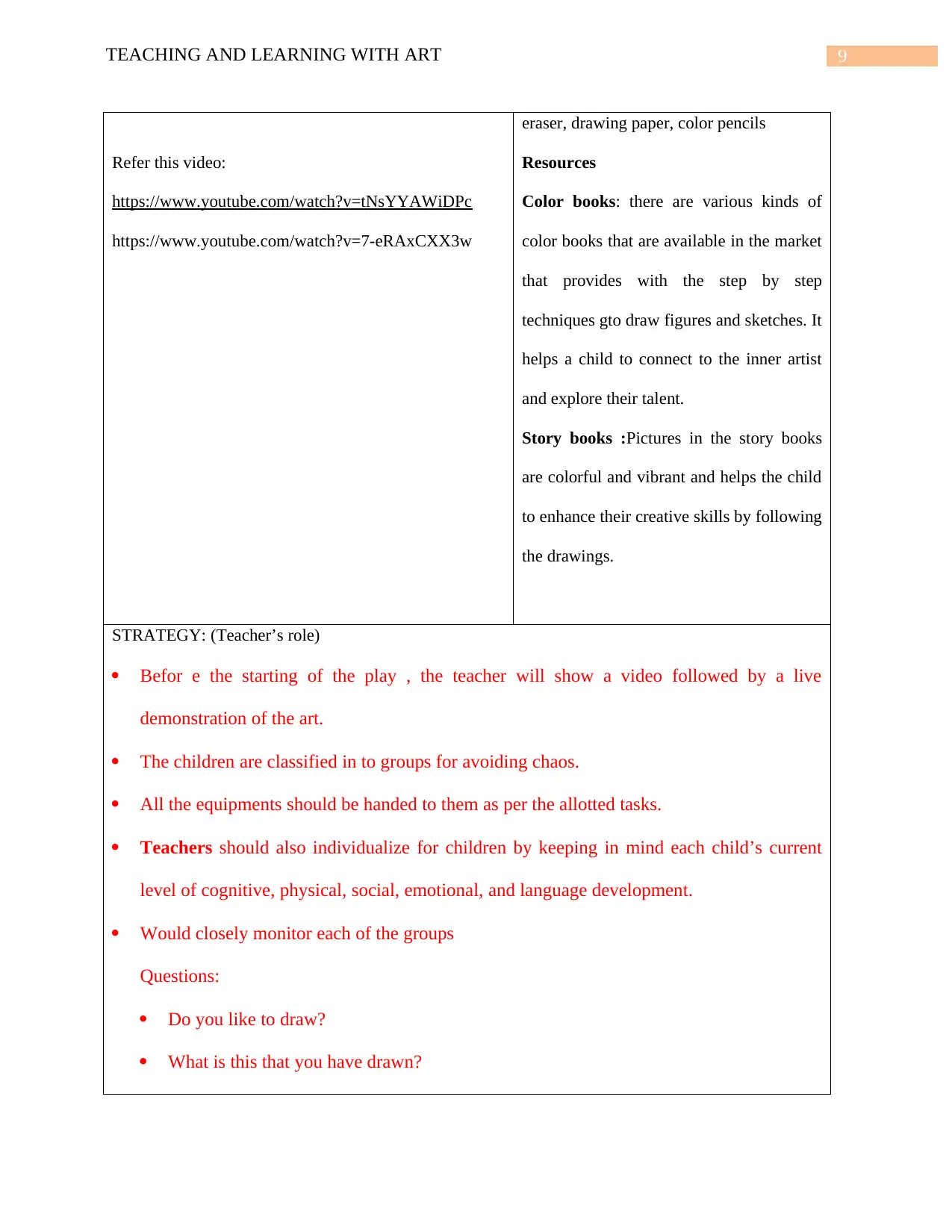
9TEACHING AND LEARNING WITH ART
Refer this video:
https://www.youtube.com/watch?v=tNsYYAWiDPc
https://www.youtube.com/watch?v=7-eRAxCXX3w
eraser, drawing paper, color pencils
Resources
Color books: there are various kinds of
color books that are available in the market
that provides with the step by step
techniques gto draw figures and sketches. It
helps a child to connect to the inner artist
and explore their talent.
Story books :Pictures in the story books
are colorful and vibrant and helps the child
to enhance their creative skills by following
the drawings.
STRATEGY: (Teacher’s role)
Befor e the starting of the play , the teacher will show a video followed by a live
demonstration of the art.
The children are classified in to groups for avoiding chaos.
All the equipments should be handed to them as per the allotted tasks.
Teachers should also individualize for children by keeping in mind each child’s current
level of cognitive, physical, social, emotional, and language development.
Would closely monitor each of the groups
Questions:
Do you like to draw?
What is this that you have drawn?
Refer this video:
https://www.youtube.com/watch?v=tNsYYAWiDPc
https://www.youtube.com/watch?v=7-eRAxCXX3w
eraser, drawing paper, color pencils
Resources
Color books: there are various kinds of
color books that are available in the market
that provides with the step by step
techniques gto draw figures and sketches. It
helps a child to connect to the inner artist
and explore their talent.
Story books :Pictures in the story books
are colorful and vibrant and helps the child
to enhance their creative skills by following
the drawings.
STRATEGY: (Teacher’s role)
Befor e the starting of the play , the teacher will show a video followed by a live
demonstration of the art.
The children are classified in to groups for avoiding chaos.
All the equipments should be handed to them as per the allotted tasks.
Teachers should also individualize for children by keeping in mind each child’s current
level of cognitive, physical, social, emotional, and language development.
Would closely monitor each of the groups
Questions:
Do you like to draw?
What is this that you have drawn?
Paraphrase This Document
Need a fresh take? Get an instant paraphrase of this document with our AI Paraphraser
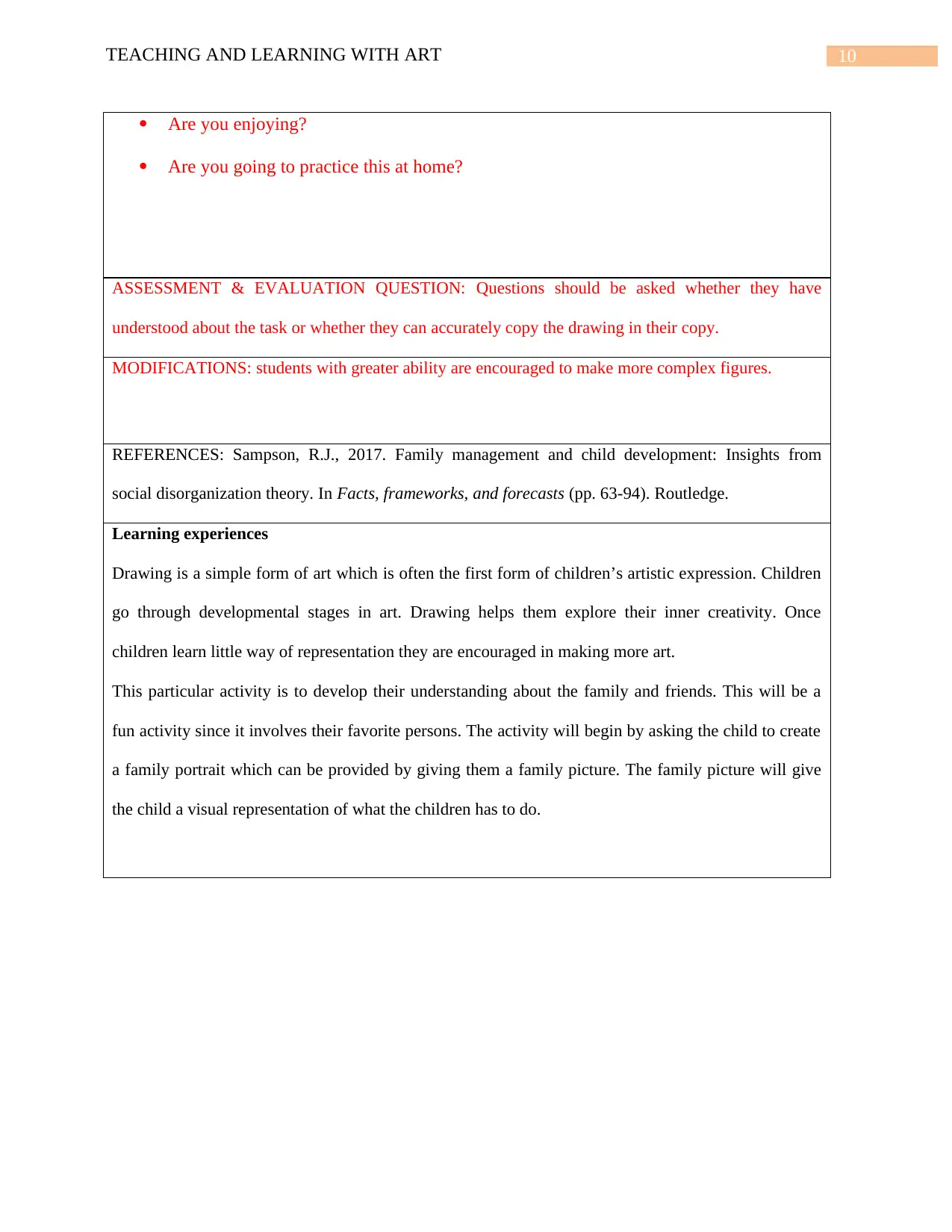
10TEACHING AND LEARNING WITH ART
Are you enjoying?
Are you going to practice this at home?
ASSESSMENT & EVALUATION QUESTION: Questions should be asked whether they have
understood about the task or whether they can accurately copy the drawing in their copy.
MODIFICATIONS: students with greater ability are encouraged to make more complex figures.
REFERENCES: Sampson, R.J., 2017. Family management and child development: Insights from
social disorganization theory. In Facts, frameworks, and forecasts (pp. 63-94). Routledge.
Learning experiences
Drawing is a simple form of art which is often the first form of children’s artistic expression. Children
go through developmental stages in art. Drawing helps them explore their inner creativity. Once
children learn little way of representation they are encouraged in making more art.
This particular activity is to develop their understanding about the family and friends. This will be a
fun activity since it involves their favorite persons. The activity will begin by asking the child to create
a family portrait which can be provided by giving them a family picture. The family picture will give
the child a visual representation of what the children has to do.
Are you enjoying?
Are you going to practice this at home?
ASSESSMENT & EVALUATION QUESTION: Questions should be asked whether they have
understood about the task or whether they can accurately copy the drawing in their copy.
MODIFICATIONS: students with greater ability are encouraged to make more complex figures.
REFERENCES: Sampson, R.J., 2017. Family management and child development: Insights from
social disorganization theory. In Facts, frameworks, and forecasts (pp. 63-94). Routledge.
Learning experiences
Drawing is a simple form of art which is often the first form of children’s artistic expression. Children
go through developmental stages in art. Drawing helps them explore their inner creativity. Once
children learn little way of representation they are encouraged in making more art.
This particular activity is to develop their understanding about the family and friends. This will be a
fun activity since it involves their favorite persons. The activity will begin by asking the child to create
a family portrait which can be provided by giving them a family picture. The family picture will give
the child a visual representation of what the children has to do.

11TEACHING AND LEARNING WITH ART
Gross motor skills
Activity 3
Art type Visual art
Title of the activity Construction activity
Age Level (5-6)
Explore and express
ideas
Child will be able to
explore new ideas apart
from what is given in
the manual
Arts practice
It will increase the
creativity such as the
color combination of
the blocks or the type
of building that has to
be constructed.
Present and perform
A child will be able to
display a completed
constrauction work.
Respond and
interpret
A child will be able to
understand the
importance of the
construction play.
Learning intentions:Construction activities for the children helps in the whole body movement
involving the large muscles of the body to perform the functions like walking, standing, sitting upright
Gross motor skills
Activity 3
Art type Visual art
Title of the activity Construction activity
Age Level (5-6)
Explore and express
ideas
Child will be able to
explore new ideas apart
from what is given in
the manual
Arts practice
It will increase the
creativity such as the
color combination of
the blocks or the type
of building that has to
be constructed.
Present and perform
A child will be able to
display a completed
constrauction work.
Respond and
interpret
A child will be able to
understand the
importance of the
construction play.
Learning intentions:Construction activities for the children helps in the whole body movement
involving the large muscles of the body to perform the functions like walking, standing, sitting upright
⊘ This is a preview!⊘
Do you want full access?
Subscribe today to unlock all pages.

Trusted by 1+ million students worldwide
1 out of 24
Related Documents
Your All-in-One AI-Powered Toolkit for Academic Success.
+13062052269
info@desklib.com
Available 24*7 on WhatsApp / Email
![[object Object]](/_next/static/media/star-bottom.7253800d.svg)
Unlock your academic potential
Copyright © 2020–2026 A2Z Services. All Rights Reserved. Developed and managed by ZUCOL.





